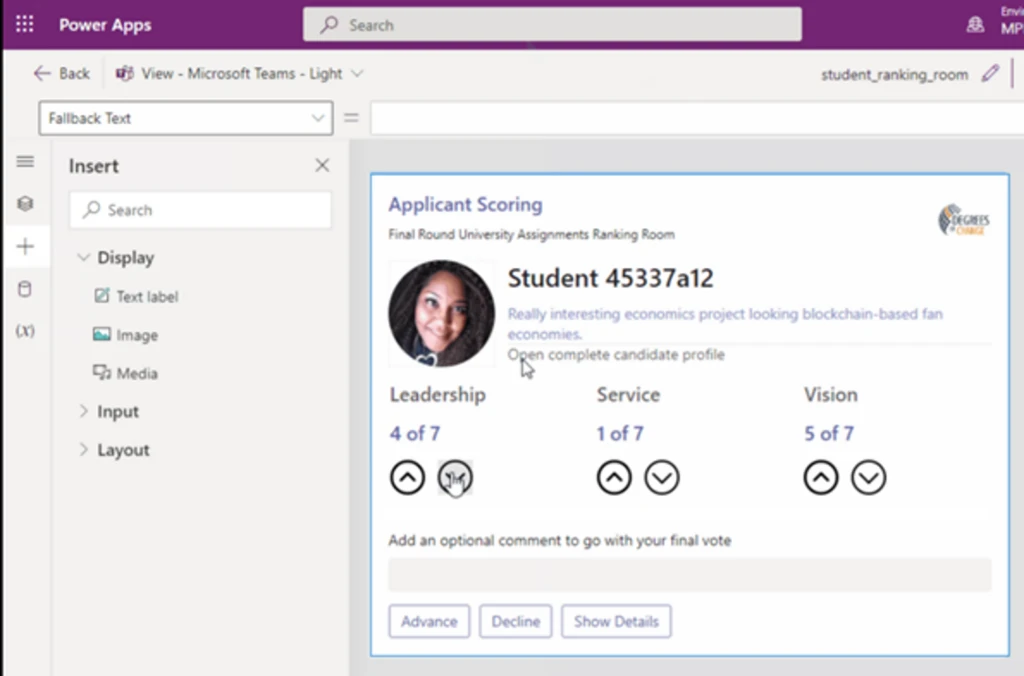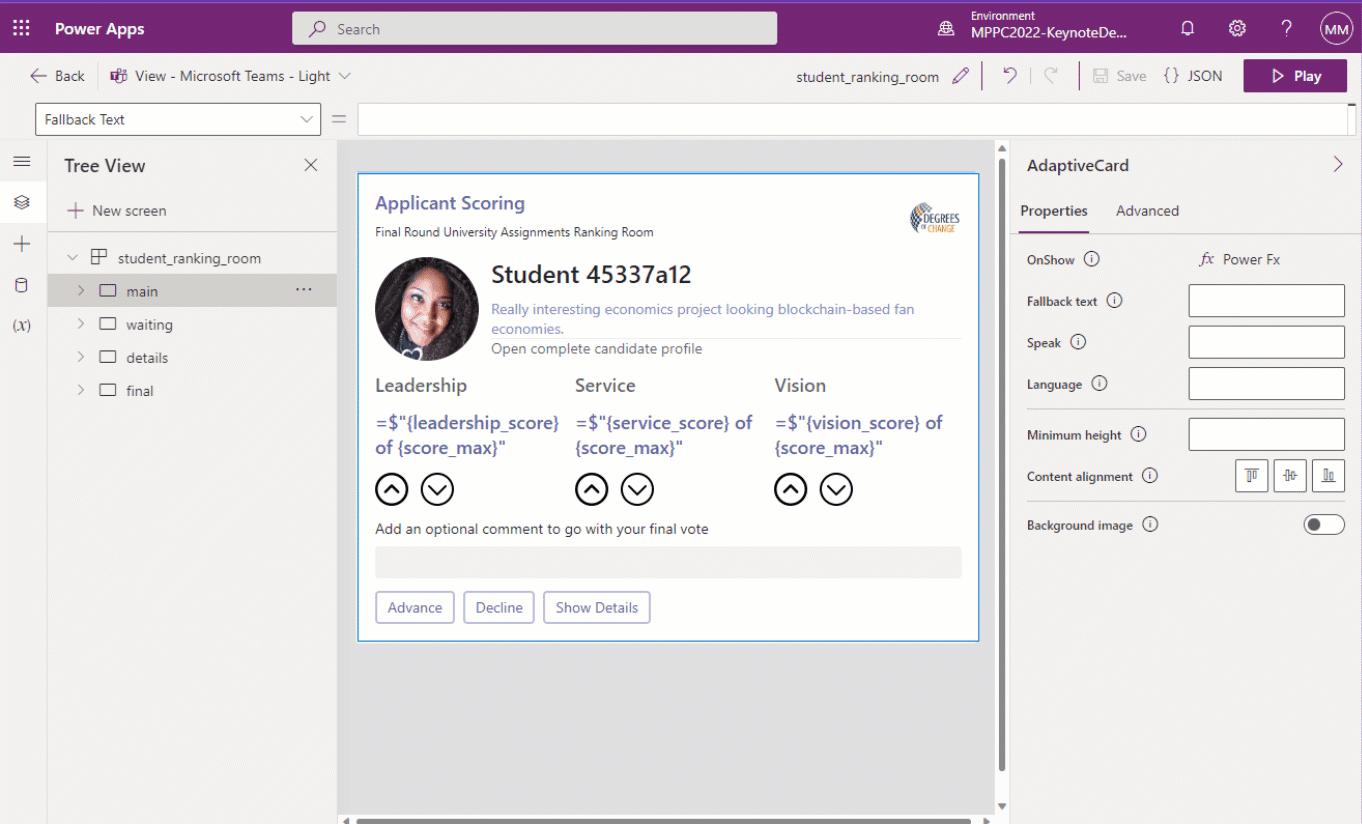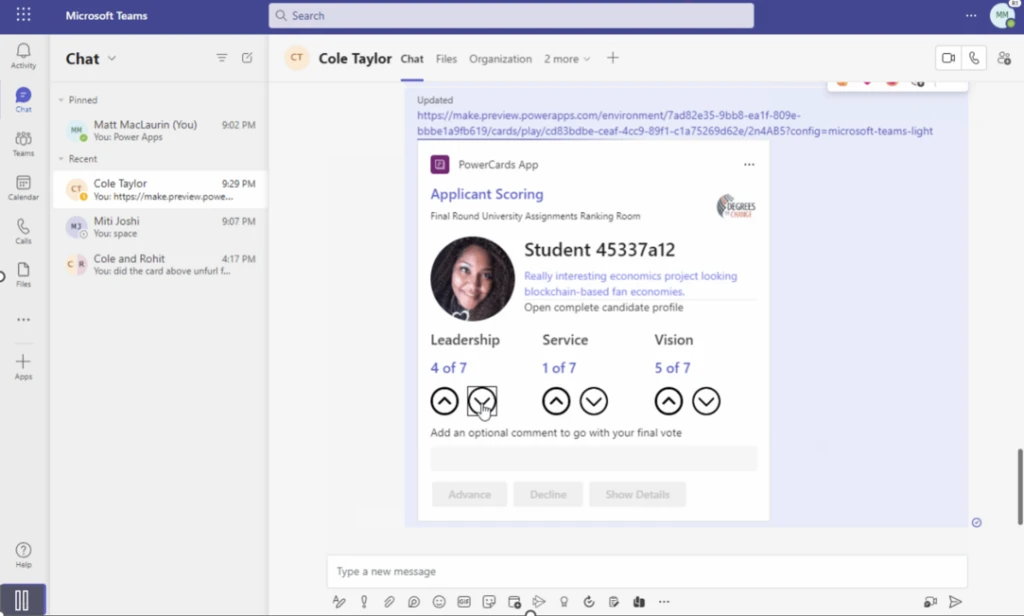
Power Apps brings collaboration to center stage with 3 big announcements
As we kick off the first ever Microsoft Power Platform Conference to a sold-out crowd buzzing with energy, the power of a thriving and collaborative low code community has never been clearer. Our major product announcements today reflect that truth. We’re excited to share three important new ways to collaborate – whether you’re building an app together with a team, looking for help inside your company, or taking Teams itself to the next level as a collaborative workplace.
What’s new in a nutshell (with a lot more detail below):
Cards for Power Apps are a completely new way to design and deliver mini-apps directly inside Microsoft Teams and Outlook using low code. By embedding essential micro-experiences directly in Teams, you can bring your conversation and workflow together like never before.
Coauthoring is coming to Power Apps as well, using the same realtime collab capabilities that millions of people are using in Office 365. This is a big step forward for software development, allowing multiple makers to collaboratively build and edit the same app simultaneously.
Maker matching, delivered with a new integrated virtual agent, will help guide makers to the learning content they need while also connecting them with experienced advisors from within their organization. In-context help together with well-connected internal communities means more successful low code solutions at scale.
Cards for Power Apps
Cards for Power Apps is a new addition to the low code lineup, allowing business users and developers alike to build visual, interactive, data-driven, and actionable cards. These embeddable micro-apps can be shared with other people in Teams and Outlook with a customizable visual interface.

Cards for Power Apps is based on the popular Adaptive Card framework, used by professional developers to serve millions of users with pre-built actionable cards today. By bringing this capability to low code, we’re dramatically broadening who can build and deliver lightweight, embedded experiences.
Get started in minutes with a no-code card designer
The drag-and-drop card designer has all the same familiar elements of Power Apps. Makers can create a customized card UI consisting of buttons, tables, text, images, options, checkboxes, input fields, containers, and many other components without writing any code.
Add data and connect to services
The Power Platform Connectors in the card designer will allow users to connect to enterprise data and back-end services safely and securely, filling the card with relevant data when a user sees it in Teams. Of course, Microsoft Dataverse is built right in as well, making it possible to easily build lightweight cards backed by a powerful enterprise data platform.

Add business logic with Power Fx
Support for Power Fx – the open-source low code programming language based on Excel – makes fast inline calculations and dynamic actions possible in cards. Makers can create sophisticated logic, including data operations performed via Power Platform Connectors, connected to interactive UI elements in the card.
Send your cards in Teams
Users can post their cards in Teams Channels, chats and meetings. Links to cards will automatically render into a full interactive card inline, filled with data, all while keeping enterprise data securely within an organization.

Cards are rolling out now in public preview to Power Apps makers and should light up in your region soon. The first wave will build on Dataverse as a backend and use Teams as the target for sharing; we’ll be rapidly lighting up Power Platform connectors and additional sharing options over the coming months. We hope you love this amazing new capability to build embeddable, interactive, and actionable cards in Power Apps and cannot wait to hear your feedback. Happy card building!
Coauthoring in Power Apps
Developing software has traditionally been a “single player” experience. Developers check out code to a local branch, make their changes individually, and merge back to the main project. Until now, the vast majority of low-code development has followed a similar pattern of one maker per component at a time.
With coauthoring, all of that changes dramatically. Now multiple makers will be able to see who else is present in the app, see what parts of the app other makers are working on, and see changes made to the app in real-time. Makers can add new pages and work on them without disturbing others’ work. This dramatically improves collaboration and development efficiency, no matter whether you’ve been a software developer for your entire career or are just getting started with low code.

Just like Office 365, makers can see who else is building in their app and easily chat with them. You can tag people in comments for asynchronous communication, or everyone can open an app and watch each other make changes together in the real-time. The difference is that it’s not one person sharing the screen, it’s everyone seeing the same version of the app and having the ability to add/edit/remove app components without disturbing work of other makers.
We’ve heard from many customers that they want to use coauthoring to help new makers grow within the organization. With coauthoring, novice makers can shadow experienced makers to watch them build an app or complete the tasks that experienced maker set up for them. Whether you have a new cohort of developers or your marketing department wants to learn how to build internal apps, you can start a project and teach them in a single environment.
Coauthoring is rolling out now for makers using the modern app designer.
Maker matching with an integrated virtual agent in Power Apps
To assist makers in their learning and development journey, we are introducing an integrated virtual agent in Power Apps that can guide makers to Power Apps learning content as well as internal resources specific to an organization. But the special thing about this bot is that it isn’t just a bot – Power Apps will also match users with more experienced makers from their own organization, right within the product. Maker matching connects to people who can advise new makers during development – enabling people to build apps better and faster with help that is ‘close to home’. The virtual agent also surfaces internal community channels and resources to help you build and stay connected to your maker community.

Experienced makers can be nominated as Advisors into the Advisor Program in one of two ways. Admins can assign specific individuals as advisors. Over time successful makers with strong track records will also automatically receive in-product invitations through intelligent matching. Once nominated, advisors will then be prompted in Power Apps to opt into the Advisor program and they can start helping new makers in their organization.
The virtual agent will begin matching makers soon in public preview.
What’s next?
You can try all these features and more by signing up for a free developer plan to build apps or a free trial to use apps that other makers have built.
Want to do more with premium connectors and Dataverse? Check out paid plans.
